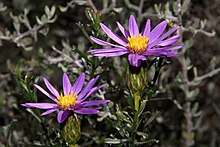Olearia magniflora
Olearia magniflora, commonly known as the splendid daisy-bush,[2] is a small shrub with clusters of deep mauve to purple flowers.
| Splendid daisy-bush | |
|---|---|
 | |
| Olearia magniflora growing near Mildura | |
| Scientific classification | |
| Kingdom: | |
| (unranked): | |
| (unranked): | |
| (unranked): | |
| Order: | |
| Family: | |
| Tribe: | |
| Genus: | |
| Species: | O. magniflora |
| Binomial name | |
| Olearia magniflora | |
Description
Olearia magniflora is sprawling upright shrub to 1.5 m (4.9 ft) high with upright stems and an open habit. The branches are smooth and more or less woody. The sessile leaves are dark green above and paler underneath, smooth, slightly sticky and sparsely arranged alternately along the stem. The leaves vary from wedge-shaped or broader at the apex narrowing at the base, 8–18 mm (0.31–0.71 in) long and 2–5 mm (0.079–0.20 in) wide with a prominent mid-vein, usually 3-5 toothed edges at the apex and rolled margins. The single cluster of 14-20 flowers appear at the end of branches on a short stem less than 1 cm (0.39 in) long. The mauve to purple "petals" (strictly ligules of the ray florets) are linear and 18–24 mm (0.71–0.94 in) long. The flower centre is a yellow disk of 30-56 florets. The oval to linear overlapping bracts are arranged in rows of 4-5 and 15–20 mm (0.59–0.79 in) long, smooth and finely fringed. The dry fruit are one-seeded, smooth, compressed needle-shaped, 3–5 mm (0.12–0.20 in) long and with fine longitudinal lines. The seed is dispersed at maturity. Flowers from July to January.[2][3]
Taxonomy and naming
The splendid daisy-bush was first described in 1865 by Ferdinand von Mueller who called it Aster magniflora and published the description in Fragmenta phytographiae Australiae.[4] In 1867 George Bentham changed the name to Olearia magniflora and published the change in Flora Australiensis.[5][6]
Distribution and habitat
The splendid daisy-bush grows in New South Wales, Victoria, Western Australia and South Australia. In New South Wales it is found mainly growing from Balranald and Wentworth areas and north to Wilcannia. It grows in heath, woodland and mallee in well-drained, sandy loam soils.[2][3]
References
- "Olearia magniflora". Australian Plant Census. Retrieved 16 June 2019.
- Lander, N.S. "Olearia magniflora". PlantNet NSW FLORA ONLINE. Royal Botanic Gardens Sydney. Retrieved 16 June 2019.
- "Olearia magniflora". eFloraSA. Retrieved 16 June 2019.
- "Aster magniflora". APNI. Retrieved 24 June 2019.
- "Olearia magniflora". APNI. Retrieved 24 June 2019.
- Bentham, George; Mueller, Ferdinand (1867). Flora Australiensis. London: Lovell Reeve & Co. pp. 480–481. Retrieved 24 June 2019.